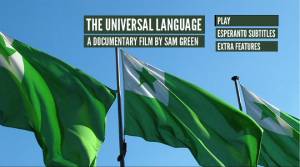Review of The Universal Language documentary Posted by Chuck Smith on Jul 8, 2011 in Uncategorized
After seeing Sam Green’s Utopia In Four Movements, I was very excited when his new DVD The Universal Language appeared in my mailbox. It’s a half hour documentary about Esperanto from a relatively neutral viewpoint about the language. From a technical viewpoint, he does a very good job producing a professional documentary, even including archive clips and photos with footage from old conferences and even Zamenhof himself!
In the beginning it starts out very promising asking, “Why do I think you might be interested in learning that language [Esperanto]?” followed by a short introduction of the language. Throughout the documentary, he has interesting interviews with several prominent Esperanto speakers including Arika Okrent, the author of In The Land of Invented Languages. Of her interview, my favorite part was when she mentioned a very interesting tidbit of Esperanto history. I’m speaking of the Texel Island in the Netherlands. There stands a large Esperanto monument where in 1935, there were 1000 people who spoke Esperanto in a place with only 8000 people. Can you imagine that?
The documentary also stars Humphrey Tonkin, a former president of the Universal Esperanto Association who is now a professor at the University of Hartford. He does a splendid job presenting Esperanto in a very positive way without ever making it feel like propaganda. I especially loved when Tonkin said, “What Zamenhof did was not really create a language. He wasn’t interested in the language as a language. He created a community and a history in effect from scratch. This was brilliant and it worked!”
In short, Green presents the history well, but there’s very little focus on how Esperanto can be used today. As a historical documentary, he hits the nail on the head, but when it comes to current usage of Esperanto, it falls quite short. For example, there’s no mention of the Esperanto hospitality network, Pasporta Servo, books, music, and other ways to use Esperanto today. In fact, the only event he covers is the Universala Kongreso de Esperanto in Yokohama, but unfortunately a lot of the documentary consists of Esperanto speakers in front of a white screen, often when they’re not expecting the footage to be used in final production. To his credit, he does show how widely Esperanto is spoken by presenting Esperanto speakers from all around the world, including more exotic countries like New Caledonia, Nepal and Iran.
I’ve exchanged many emails with Sam Green and I know he means well. I personally think he finds Esperanto’s history fascinating while I’m personally more interested in ways to use Esperanto today. To be fair, you do hear a lot of Esperanto spoken naturally (with English subtitles), showcasing it as a real, living language. His interview with a native Esperanto speaker, DJ Leo Sakaguchi helps to show the life and importance of the language as well. Also, he makes good use of Esperanto music throughout the film which further helps to show off more of Esperanto culture.
Due to the assistance of the Esperanto workgroup Filmoj Sen Limoj, the DVD includes subtitles in Esperanto making it suitable for showing at your local Esperanto club, especially outside English-speaking countries. All in all, even though it’s not perfect, it’s quite a nice film, and I’d especially recommend it to anyone interested in Esperanto’s history. The DVD will soon be available for purchase on the official documentary website.

Build vocabulary, practice pronunciation, and more with Transparent Language Online. Available anytime, anywhere, on any device.
About the Author: Chuck Smith
I was born in the US, but Esperanto has led me all over the world. I started teaching myself Esperanto on a whim in 2001, not knowing how it would change my life. The timing couldn’t have been better; around that same time I discovered Wikipedia in it’s very early stages and launched the Esperanto version. When I decided to backpack through Europe, I found Esperanto speakers to host me. These connections led me to the Esperanto Youth Organization in Rotterdam, where I worked for a year, using Esperanto as my primary language. Though in recent years I’ve moved on to other endeavors like iOS development, I remain deeply engrained in the Esperanto community, and love keeping you informed of the latest news. The best thing that came from learning Esperanto has been the opportunity to connect with fellow speakers around the globe, so feel free to join in the conversation with a comment! I am now the founder and CTO of the social app Amikumu.





Comments:
Sam Green:
Hi Chuck, Thanks for this. I appreciate the review. We are currently in the last stages of putting together a DVD of “The Universal Language”. Filmoj Sen Limoj helped us to translate the film into a total of 20 different languages! (Finnish, Maltese, Chinese, Korean, etc), so I’m hoping to distribute the film widely and that it will be useful to Esperantists around the world. I will let you know when the DVD is done and the website is ready – it should be in a couple of weeks. In the meantime, people can reach me at samgreenfilm@gmail.com
Ant Writes:
Bonega recenzo….kvankam mi ankoraǔ atendas “Utopion” ĉe Netfix 🙂
Jeff:
So I’ve attempted to do a good search around google to try and find the ending credit music to the documentary but I couldn’t find anything that would link back to it. I searched all the names in the credits for music and DJ Leo. Couldn’t come up with anything. Any idea?
Sam Green:
The credits music from The Universal Language is a great song by a Brazilian artist name Tone. The song is called “Nova Kanto.” It’s a fantastic tune (the words are good too), and a warning: it will become profoundly stuck in your head!